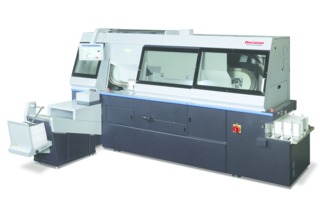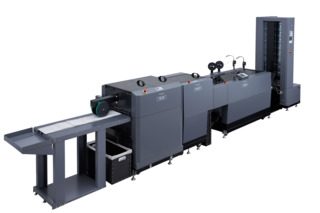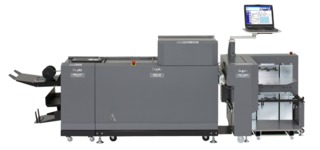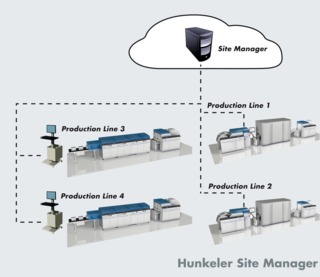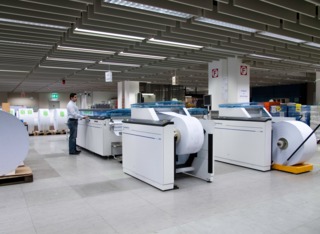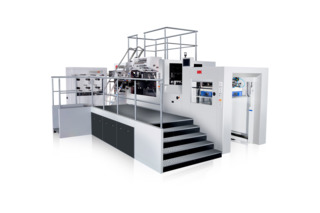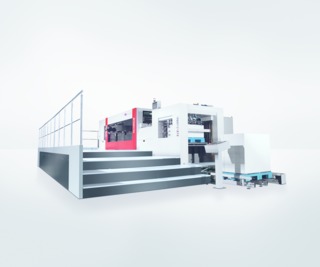Putting an End to the Finishing Bottleneck
Increased automation is removing the need for manual intervention between steps and maximizing productivity.
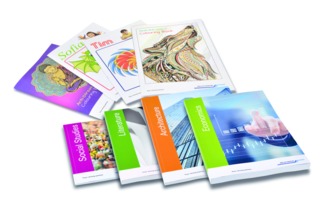
In the past, the finishing area’s rep was as a bottleneck area, a rep that grew when legacy offset presses began turning out the pages at lightning speeds, and continuing on when short-run, quick turnaround, smaller volume became the norm within the printing industry. Much of the finishing equipment couldn’t keep up with the newer, faster presses.
However, as the market shifted, from static, long runs with delivery dates noted well in advance to shorter run, quick turnaround, and variable jobs, post-press vendors introduced advancements to their equipment that have allowed finishing to catch up and keep up with customer demands. Much of the equipment available today is designed to be part of a system that has fewer touchpoints, leading to less operator error and reduced downtime.
“Increased automation and multi-functional machines have reduced manual touchpoints, streamlined workflows, and are designed to keep up with the fastest presses on the market, whether configured inline or offline,” said Will Frank, marketing specialist, Standard Finishing Systems.
“They are adapted to the increasingly important requirements of short-run work. For example, the new Standard Horizon BQ-480 Perfect Binder features the quickest setup and changeover for variable book production in its class, with a maximum speed of 800 books per hour for book-of-one production,” added Frank.
Standard’s focus cuts a broad swath, both in-line and near-line, and includes equipment for die-cutting, perfect binding and trimming, slitting and creasing, folding, saddle-stitching, inspection systems, and roll-fed print solutions.
Print service providers want the most effective and efficient results from their production systems. They expect consistent productivity that extends from prepress to the pressroom and into their finishing processes.
New standards for versatility
Across the board, finishing suppliers are answering the call for increased productivity and automation. At drupa 16, Muller Martini’s Finishing 4.0, focused on the intelligent connectivity of its machines, designed to enable highest variability and flexibility with regards to print run lengths, format sizes, and content.
Heidleberg’s expanding post-press portfolio includes new offerings in the packaging arena , such as the Promatrix 106 FC die cutter with hot-foil embossing, Powermatrix 106 CSB die cutter with inline blanking, and the Diana Easy 115 folder. The company’s pursuing a platform that integrates prepress, press, and post-press designed to help customers increase productivity, drive down waste, and open up new business opportunities. For example, the Promatrix die cutter was designed to eliminate the need for hand-stripping of carton blanks, and to allow customers to increase productivity and reduce manufacturing costs.
While Ricoh doesn’t manufacture its own finishing equipment, it works closely with its finishing partners to identify the systems that best support the daily workloads of its clients. Specifically, it looks to bring in systems that help its customer produce a finished product in tight turnaround times, says John Fulena, vice president, Production Printing Business Group, Ricoh.
Ricoh’s expanded range of recommended finishing solutions is designed to help its customers streamline the cost efficient delivery of print. Several years ago, Ricoh’s third-party finishing offerings were fairly limited. “But around five or six years ago we realized that we needed to expand our offerings to be able to offer our customers in the US a wider range of options,” said Fulena. “We did our research and began to offer more resources. That part of our business exploded, growing from zero to a multi-million dollar operation in just three or four years.”
Ricoh’s now has nearly 20 finishing partners, including C.P. Bourg, Duplo, Drylam, Morgana, PSI Engineering, and TEC Lighting. It offers both in-line and off-line options that includes laminators, cutters, folders, bookletmakers, and plotters.
Part of Ricoh’s approach is to help its customers set up a system for a specific application, such as bookletmaking. Recently added to its cadre of available options, the Duplo DBM 350 and Duplo DBM 600 bookletmakers are highly automated machines that are manufactured for quick to set up and ease of use, enabling the efficient handling of fast turnaround booklet production.
Multi-functional machines have set a new standard for versatility and efficiency in the bindery, says Frank. “The Standard Horizon SmartSlitter is an all-in-one smart sheet processing system that can slit, gutter cut, edge trim, cross-cut, perforate, and crease all in one pass. You’ll also find multiple pieces of hardware combined into a single line, removing the need for manual intervention between steps and maximizing productivity. The Standard Roll-to-Booklet line integrates the Horizon StitchLiner 6000 Digital high-speed saddlestitcher with Hunkeler’s UW6 unwinder and CS6 rotary cutter for production of up to 6,000 high-quality booklets per hour, inline with continuous feed printers. Deep technical integration is critical to a solution like this to ensure that all systems interoperate cleanly, so it’s important that suppliers facilitate tight coordination between manufacturers, as Standard has done between Horizon and Hunkeler. The customer also benefits from a single-source solution; one supplier can support the entire system.”
Opportunity awaits
Finishing has long shed its historic image as solely a cost center, and is now viewed as an area of opportunity. With the right equipment, providers can differentiate themselves and add value to their finished products. Die cutting, embossing/debossing, and other finishing touches allow greater customization and flexibility than ever before, so creativity and top-quality products can shine.
Standard recently introduced a new configuration for the Horizon RD-4055 Die Cutter, a Dual Magnetic Cylinder setup that brings a new level of versatility to the already robust RD-4055 system. The DMC can handle more complex creasing patterns and even light packing applications, presenting unique opportunities for savvy printers to make their finished products stand out.
The feature set continues to improve with post-press equipment, even as the price of the technology comes down, says Fulena. As customers continue to add finishing services, they are looking to become more self-sufficient and offer their customers a full slate of services.
“Our philosophy and strategy is to not only sell finishing devices but also to service them,” said Fulena. “We understand that commercial printers and sign manufacturers can’t afford to be down, and that they rely on this equipment. We are very cognizant of this. “
What Ricoh is selling is solutions, says Fulena. “The customer lets us know the applications they are looking to produce – booklets, calendars, etc. What we can provide is an end-to-end solution. It’s easier to source the equipment, easier to finance, easier to service. What we’ve become is kind of an integrator. The PSP doesn’t have to buy the press from us, the prepress elsewhere, the finishing elsewhere. When you buy from all these different vendors, no one wants to take responsibility if something goes wrong; the last thing the customer wants to see vendors pointing fingers at each other. We offer one single solution; if something goes wrong, they only have to make one phone call.”
The final frontier
As the print industry continues its evolution, post-press has become the final frontier for automation, says Frank.
“We expect providers to eventually demand not just fully automated post-press setups, but real time production statistics on work in progress, predictive maintenance, and more, all flowing backing into their MIS system to inform their decision making. This is the type of control and efficient reporting that providers already demand from their pressroom; we expect these same expectations to extend to the bindery.”
To that end, Hunkeler has developed Site Manager to collect error data and status from tracking controllers on Hunkeler finishing devices and provide production reporting and piece level tracking. Site Manager can also integrate with the Hunkeler WI6 Web Inspection system, which captures high-resolution images of printed output for various types of quality and integrity analysis at speeds up to the full speed of the press.

